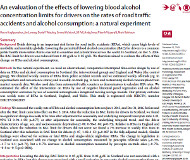1/11/2019
Scotland: Lowering Drunk Driving Limit Did Nothing For SafetyMedical journal finds lowering of the drunk driving threshold to .05 failed to reduce traffic accidents in Scotland.

Lowering the threshold for convicting a motorist of drunk driving has done nothing to improve road safety in Scotland. The Lancet, a respected medical journal, last month examined the impact of Scotland's lowering of the motorist's legal blood alcohol content (BAC) level from .08 to .05. The change took effect on December 5, 2014, giving the team funded by the UK National Institute for Health Research four years of accident statistics to draw their results.
"After the reduction in BAC limits for drivers in Scotland, we found no significant change in weekly road traffic accident rates after adjustment for seasonality and underlying temporal trend," the researchers explained in the Lancet. "Relative to road traffic accidents in England and Wales, where the reduction in BAC limit for drivers did not occur, we found a seven percent increase in weekly RTA rates in Scotland after this reduction in BAC limit for drivers."
The researchers also gathered alcohol sales numbers for a rough estimate of the impact on per-capita alcohol consumption. They found little change there as well.
Lowering the trigger for drunk driving convictions, like lowering speed limits, is one of the quick fixes suggested by adherents of Vision Zero transportation policy. In the United States, Utah became the first state to formally adopt a 0.05 BAC policy on December 30. The District of Columbia in 2005 revised its drunk driving ordinances to say that a person could be convicted of driving under the influence with a BAC reading as low as 0.05.
Prior to the change, DC motorists were being arrested for DUI after having a single drink, regardless of the breath test results. Critics charged that arresting sober individuals did nothing to stop the hard-core drinkers who are the ones most likely to get behind the wheel and cause accidents.
"The most frequently recorded BAC among all drinking drivers in fatal crashes in 2010 was .18, more than twice the legal limit in every state," a National Highway Traffic Safety Administration report explained.
The same dynamic may be at play in Scotland. The study noted that no other enforcement measures, such as random stops to force motorists to take breath tests, took place during the study period. The researchers say more information is needed.
"It could be that road traffic accidents that are not related to alcohol have increased in Scotland during the study period, masking an intervention effect," the study concluded. "Given the modeling results, we think this explanation is unlikely. Further research exploring these and other possible explanations for the findings is needed."
A copy of the study is available in a 400k PDF file at the source link below.


